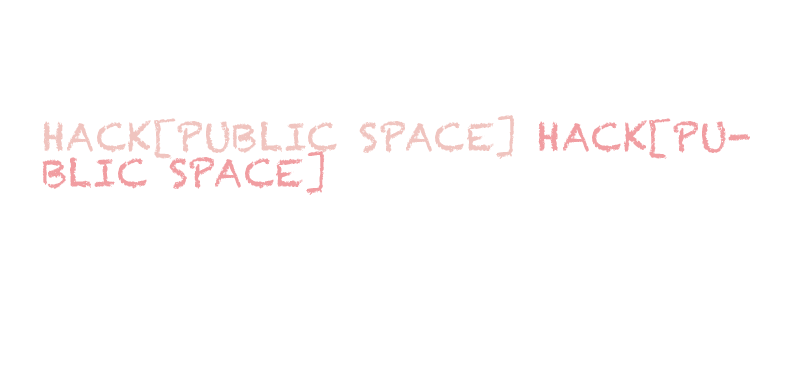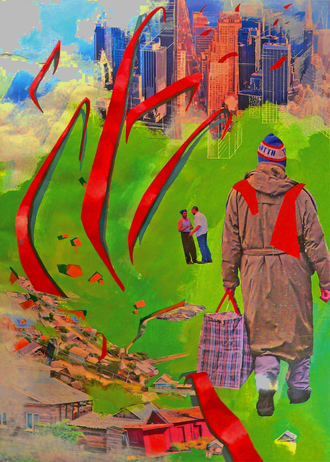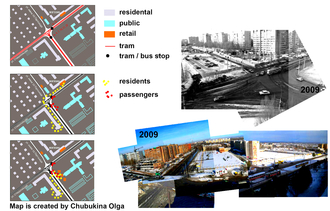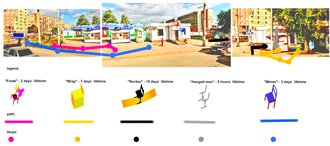
Reshetnikova Tatiana Sergeevna is Architect and researcher at
Bauhaus-Universität Weimar and Saint Petersburg State University of
Architecture and Civil Engineering.
Nicolai Konstantinovich Petrov is Architect at Saint-Petersburg, Russia.
How to quote this text: RESHETNIKOVA, T. S.; PETROV, N. K., 2014.
Virus-objects:urban invaders. V!RUS, 10. [e-journal] Available at:
<http://www.nomads.usp.br/virus/virus10/?sec=7&item=2&lang=en>
[Accessed dd mmm yyyy].
Abstract
Understood as a practice of urban improvement and emphasis on the value of
local space through individual artistic contribution, “Do It Yourself” was
initiated by us to verify a pure artistic concept of public curiosity about
unusual objects in urban space and, simultaneously, to entertain citizens and
to get people thinking creatively about their surroundings and, therefore, to
activate an anonymous, “nobody`s”, place.
To attain these objectives, several experiments were conducted under the
concept of “Virus-object”, in which “Virus-object” acted as a design object
that is artistic, alien by nature - contrasting the surroundings, ready for
operation (“communicative”) and productive outdoor object. The experiments
consisted of a set design objects - modified / decorated / constructed and/or
reconstructed objects with an unusual, vivid, monstrous and bizarre appearance
in particular context to induce viewers` interest, emotions, and communication.
In the project of virus-chairs, where chair artifact was taken as a base form
for virus-objects, as well as in students` experiments curated by the author, a
special attention was paid to the design of virus-objects, which appeared as
heroes with their own destiny, drama and character. Termed “Virus-objects”,
these artifacts were implanted without authorization or anyone permission and
under cover of darkness in city organism. Afterwards, monitoring with video
recording of located virus-objects revealed expected and awaited interest of
people, who had started to communicate with virus-objects – playing,
destroying, stealing, using.
The concept and project “Virus-object” emphasized the role of creative
initiatives in understanding the values of the urban environment given by the
community.
Keywords: DIY, urban invader, virus-object, urban
experiment.
Virus-objects: urban invaders
“Architecture is not simply about space and form, but also about event,
action, and what happens in space.” (Bernard Tschumi, “Manhattan Transcripts”,
1976-1981)
DIY (here): a bottom-up creative activity of urban development
initiated by non-professionals or professionals with their own resources aiming
improvement of everyday life quality; an activity that is, in addition to this,
a way to verify artistic concepts and to make a social and cultural
contribution to the city. Representing professionals, we asked ourselves how,
in accordance to our individual possibilities, a homogeneous, boring, and
anonymous urban environment could be aesthetically updated and conceptually
enlivened; what steps to take to enhance public`s interest in its immediate
surroundings and induce participation of citizens in shaping a heterogeneous
and attractive urban environment.
Problem: At the present stage, big city as well as its citizens
suffer from the chaos of information, never-ending traffic noise, long
distances, etc. This “unfocused-ness” leads to aesthetic depreciation of
urban environment (particularly in Russia, relevant for formed non-central
parts of city), which is just a temporary space of transition and transfer, to
the loss of interest in surroundings and motivation to be interested in them,
leads to the reduction of face-to-face communication between citizens.
Alienation of people is increasing and reflecting on the space, where nothing
curious happens, only homogeneity and banality. Residents, who are somehow
bounded to their residential location, are trying to revive the space by
decorating, planting flowers, or chatting, which is an introvert activity.
Focused on their own small part of the city, residents set it against
unfamiliar and alien city beyond their colorful flowerbeds.
Relying on Nietzsche’s statement “The architect represents neither a
Dionysian nor an Apollinian condition: here it is the mighty act of will, the
will which moves mountains, the intoxication of the strong will, which demands
artistic expression” in “Twilight of the Idols” (1968 [1889]), we assume that
our creative activity has a potential to change the situation described above.
In this sense, “Do it yourself” strategy articulated by architects or artists
acquires a significance acting as social and urban trigger, synchronically. By
conceiving an object in urban space, architects manipulate public aesthetical
perception, behavior, imagination, and senses and articulate a new image of the
city.
The concept of virus-object
Using a phenomenological approach (mapping emotions, feelings produced by
particular space), intuition and creativity, we endeavored to generate a
concept for update unremarkable urban environment aiming to overwhelm
alienation, stimulate public curiosity about immediate urban space, and to
induce people to take part in shaping their surroundings. But how?
How to enhance a communication and interest in urban space by creativity?
How to stimulate urban dialogue that is a respond to the city: discourse,
aesthetical and emotional perception of space? How to activate the space, and
to emphasize and improve the urban value? How to rewrite the outmoded scenario
of particular city fragment to an entirely new intriguing, positive,
contemporary, inspiring story?
Hypothetically, the local space catches public interest when something
unusual happens there: events, renewal of objective-spatial environment or
merely a muffin-man starting his business. Attracted by something alien, new
and original in ordinary location and everyday routine, citizens are starting
the game – the communication, above-mentioned dialogue. We propose a concept of
“Virus-objects” – architectural or urban design contribution to renewal of
urban space and to people’s memory.
The term, form and features of the virus-object. The term
“Virus-object” is defined as a outdoor design object that is artistic, alien by
nature to urban environment and contrasting with its surroundings, ready for
operation (“communicative”, open and accessible) and productive. Thus, being
implanted into the city organism, virus-object inspires people to reproduce its
copies or to design congenial art. It is supposed eventual physically
(architectural) changes in the environment – in a form of mimesis of this type
of art and proliferation of creativity in various forms (Fig. 1a). In
conceptual point of view, “productive” means provoking interest, activity and
emotional respond. Conceived in human scale, virus-object acts as a
communicator, inducing communication, a generator, producing new artifacts or
concepts, and a convertor, updating and energizing depressive or aesthetically
ruined space. The virus-object penetrates into the homogeneous urban space and
plays a role of an attractor and transformer, distributing social interest and
compelling to feel, perceive, and act.

Fig. 1a. Virus-objects: communication formula.
Unusual, strange, alien, attractive, outrageous, bizarre, ugly, new, useful,
… - these adjectives describe something that touches someone's feelings. The
main feature of “Virus-objects” is highly emotional charge that is expressed in
visual appearance, and articulation in the location. The multi-valence of
virus-object, based on its communicative ability (objects can be used,
relocated, changed, etc.), and thought-provoking or irritating image, causes
citizens` “intoxication – strong emotions” (Nietzsche, 1990), intrigue, and
action, i.e. an urban game or dialogue, which means that a person responds on
the virus-object. Virus-objects as invaders of ordinary create events in the
city. (Fig.1)
Using Krauss’s (1985) terminology in regard to virus-object, its form is
“not-architecture” and not “architecture”, not a sculpture and not
“site-construction”. Artifact with not only a decorative, aesthetic, symbolical
or utilitarian, but also a productive and communicative function that brings it
to urban design objects, but not exactly, because of irrationalism and absence
of evident utility. Hence, virus-object is somewhere in-between. The artistic,
subjective and spontaneousform of virus-objects is represented in three
different “morphotypes”: “stipare” - a form that covers;
“parasitus” – a form that parasites; “liberalis” – an independent
form. Each virus-object is a temporal phenomenon. The lifetime of virus-object
varies from an instant user’s (citizen) observation and action till a long-term
period of involving many users.
The Virus-object is unique and original in its creative and spontaneous
nature, despite being a conjunction of “already constructed network of
comprehension”, ideas and meanings, according to Foucault’s (1970) thought
about originality: “[…] not the immediacy of a birth […]” and “[…] populated
entirely by those complex mediations formed and laid down as a sediment in
their own history by labour, life, and language; […] what man is reviving […]
is all the intermediaries of a time that governs him almost to infinity. […]”
(Foucault, 1970, p.330-331)

Fig. 1. Virus-objects: the intervention to the city. Collage.
Experiment
The described concept of “Virus-objects” was verified by means of artistic
experiments in particular urban context: namely, the experiment “Virus-chair”
and also, curated by Reshetnikova, successful experiments by students of the
Department of Linguistics, Cross-Cultural Communication, Service and Tourism,
the Faculty of Environmental Engineering, Samara state university of
architecture and civil engineering (SSUACE) (Fig. 9a, 9b, 9c).

Fig. 9a. Students` experiments: “Funny balloons on the tree” by Salikhova
Sabina, 2009.

Fig. 9b. Students` experiments: hanged man “Edik” by Myasnikova Sveta &
Soldatenkov Alexey, 2009.

Fig. 9c. Students` experiments: graffiti “Door to nowhere” by Soldatenkov
Alexey, 2009.
The main purpose of the “Virus-object” experiments was to design an object
that would catch public interest, cause emotions and response, promote dialogue
and initiate discursive space, and persuade to turn attention to immediate
surroundings.
The experiment “Virus-chair”
Assuming that the appearance of virus-object(-s) in an anonymous context
would evoke a vivid response, amuse citizens and energize the place, urban
experiment “Virus-chair” was conducted at Samara, Russia in Autumn 2009.
In this project, chair artifact was taken as a base form for
virus-objects (Fig.2).

Fig. 2. “Virus-chair” in virus-objects` family. Sketch
The experiment iniciated in a residential areawith cross-roads and several
public transport stops surrounded by residential high-rises, shops and a
hospital: coordinates 53.21639,50.22301, 22 Partsjezd / Stavropolskaya str.,
Samara, Russia. The place conveyed a feeling of not belonging to anyone:
“8:00, 12:00, 16:00, 20:00, 0:00 – time is getting on; light, clouds and
shadows are predictable relocating, birds and traffic are playing their chaotic
and simultaneously rhythmic sounds. This district is well designed: mixed-use
area with residential high-rises, several shops and drugstores, a hospital for
elderly, and also a library for residents; convenient transport infrastructure
– cross-roads with several tram and bus stops. All these depict Soviet urban
planning in a big Russian city with population more than 1,500 million people.
In the location, nothing has shifted radically – a stable image through many
years. It seems that nothing should be added. But… Alienated people move across
the cross-roads space, wait for transport or go home listlessly. Routine is
multiplied by flavourless of modernism of surrounding buildings and tough
planning. No poetry, no memories or legends, no events. This space is still
just a structure for filling it up with discourse, emotions and dreams.” (Fig.
2a)

Fig. 2a. The situation: location of virus-chair experiment
Five virus-objects, Virus-chairs were put in the city space under cover of
darkness. Since this “injection” the camera documented everything that happened
with objects: the game began. The life of “Virus-chairs” was video-recorded
(Fig. 2b), showing the citizens` interest.

Fig. 2b. Video shots: lifetime of virus-chairs.
Virus-chair design, character and fate. Vivid, strange, attractive,
doomed, self-contained, joyful or lovely virus-chair was a redesigned old chair
with prescribed individuality:
Bodiless, sad self-murderer “Hanged man" (Fig.3) caused anger and was
immediately thrown away by unknown after five hours of being mounted.

Fig. 3. "Hanged man" virus-chair. Concept, infinitive form and definitive
form. Drawing, photos.
Bizarre, creative "Freak" (Fig. 4) with an embedded glass with a
growing onion became an event for children, who dismantled it in two days.

Fig. 4. "Freak" virus-chair, Drawing, photo
An introvert, “thing-in-itself”, "Wrap" (Fig. 5) showed resilience
and adaptability, although suffering being used as a table by alcoholics and
students. Stolen (supposedly by them) after seven days it, hopefully, is still
alive.

Fig. 5. "Wrap" virus-chair, Painting, photo.
The most joyful and beloved one "Rocker" (Fig. 6), an optimistic
character, became an entertainment and supporter to the street sellers of
sweets and candies and passers-by. It was lost after fifteen days, despite
being constrained with a wire cable to the bus stop.

Fig. 6. "Rocker" virus-chair, Photo.
The most inert character "Mimer" (Fig. 7), who reflected the world
around, was damaged in an accident after three days. It had a virtuous life,
helping people to wait their tram.

Fig. 7. "Mimer" virus-chair, Drawing, photo
Table 1 shows the description (materials, physical dimensions) of the
virus-chairs, the perception by the citizens called “communication”, and the
effects of this communication for the object, resulted both in taken actions on
the virus-chair and in object`s lifetime. The intensity of the communication
and the degree of interest is represented in actions of people and, hence,
lifetime of virus-chair.
Table 1: “Virus-chair” experiment synopsis
|
Name of Virus-chair
|
Description:
material and dimensions (width x depth x height, cm)
|
Communication: process*
|
Communication: effect for the virus-object
|
Lifetime
|
|
“Hanged man"
|
Metal structure with a rope
45x45x65
(Figure 3. "Hanged man" virus-chair, Drawing, photo)
|
“Killed” in a short time by an unknown
|
Demounted and disappeared
|
5 hours
|
|
"Freak"
|
Multicolored artifact-assemblage with such details as an onion, that was
growing in a bin with water, and a platter
ca 60x50x80
(Figure 4. "Freak" virus-chair, Drawing, photo)
|
Used as a toy. Captured the fancy of children
|
Expropriated by children
|
2 days
|
|
"Wrap"
|
Plywood box, with symbols
65x65x65 (back-rest 15)
(Figure 5. "Wrap" virus-chair, Painting, photo)
|
Used as a table by people in the streets and people waiting for
transport.
|
Stolen
|
7 days
|
|
"Rocker"
|
A combination of metal structure –former chair – and a molded plywood
200x45x85
(Figure 6. "Rocker" virus-chair, Photo)
|
Caught the fancy of street sellers of sweets and candies and passers-by, who
wallowed with pleasure
|
Lost
|
15 days
|
|
"Mimer"
|
Painted as a picture usual wood chair
55x55x75
(Figure 7. "Mimer" virus-chair, Drawing, photo)
|
Used as a chair for sitting and putting bags on it.
|
Damaged
|
3 days
|
The experiment lasted for a bit more than two months – October, November
2009, during this time: virus-chairs were replaced many times by people,
deconstructed, used as a table or chair, demounted and/or stolen. The real
paths of virus-chairs are illustrated on the figure 8.

Fig. 8. The paths of virus-chairs.
Evaluation of the experiment results
The active use of the virus-chairs represented the curiosity about something
new and strange in anonymous space of the particular context - 22 Partsjezd /
Stavropolskaya str., Samara, Russia. The analysis of video-recording allowed to
conclude that virus-chairs with positive character (or program), such as
"Freak" and "Rocker", rejoiced and entertained people and were intensely used;
“Hanged man" as a virus-chair with negative character caused instant
indignation and was dismounted; neutral characters, such as "Wrap" or "Mimer",
were perceived as ordinary objects and, thus, were traditionally used as chairs
or tables. Although it seemed difficult to evaluate precisely emotional sphere
and negative or positive sentiments, that the objects had induced, the
experiment achieved the result of space update, creating an event and,
therefore, energizing the place.
Two main objectives were attained: 1) a pure artistic concept of public
curiosity about something alien and unusual in urban scenery, “Virus-object”
concept, was verified; and 2) people were interested and actively participated
in the described experiment, unknowingly taking care of their immediate
surroundings and being involved in urban game.
The initiated game, under “Do It Yourself” strategy, revealed the
possibility to change, socially, aesthetically and architecturally, the city
space on individual resources, albeit in micro-scale.
Conclusion
DIY strategy, as a creative practice of urban development, was initiated to
update an anonymous, homogeneous, boring urban environment.
Promotion of public interest to the surroundings as the main aim was
pursued, as well as pure artistic task, contained in creating an artifact to
induce public curiosity in urban space. “Virus-object” as anartistic expression
in urban environment was defined as a design object which contrasts its
surroundings, and acted as a communicator, generator, and a convertor, updating
and energizing aesthetically ruined city space. A concept of “Virus-object” was
formulated and assumed, as a mechanism for the bottom-up micro-scale
“renewal”.
Several artistic experiments were conducted in Samara (Russia) in 2009 to
verify the concept: namely, the experiment “Virus-chair” and, curated by
Reshetnikova students` experiments. Objects were implanted in urban organism
with subsequent monitoring and analyzing.
The experiment “Virus-chair” (chair artifact as a base for the object) was
conducted in a residential block at Samara. Vivid and strange, highly emotional
in appearance virus-chairs attracted people attention. Citizens participated in
this game - replaced virus-chairs, sat on them, dismounted them, etc. People
actively, albeit unknowingly, took part in shaping the space around, deleting
an unpleasant object or using a good one. The whole period of experiment was
video-recorded.
In accordance to the experiments, people are engaged and involved in urban
space, when it is creative and changing. Virus-objects as a form of
communicative art conceptually and emotionally enrich the surroundings and
people`s everyday routes and experience, promoting a dialogue and
entertaining.
“Virus-objects”, even in a form of temporary design (e.g. virus-chair), have
a potential of urban positive transformation. Artistic objects, public art,
which are communicative and accessible, create an event space and pose an urban
identity and non-commercial cultural consumption.
The “virus-object” method shapes an open story in the developing habitat,
increasing the degree of freedom, causing a new perception of common space and
communication by means of artistic will. The virus-objects play a role of
making sense and stimulating response, where there is nothing to talk about;
these objects create something to remember, and form a new narrative.
References
Foucault, M. (1970) The order of things: An archaeology of the human
sciences. London: Tavistock Publications.
Krauss, R.E. (1985) The originality of the avant-garde and other
modernist myths. Cambridge, Massachussets: MIT Press.
Nietzsche, F. (1968) Twilight of Idols and Anti-Christ, [online].
London: Penguin Books Limited. Available from: http://books.google.de/books?id=gjiShscV1zgC.
[Accessed:15th May 2014].
















